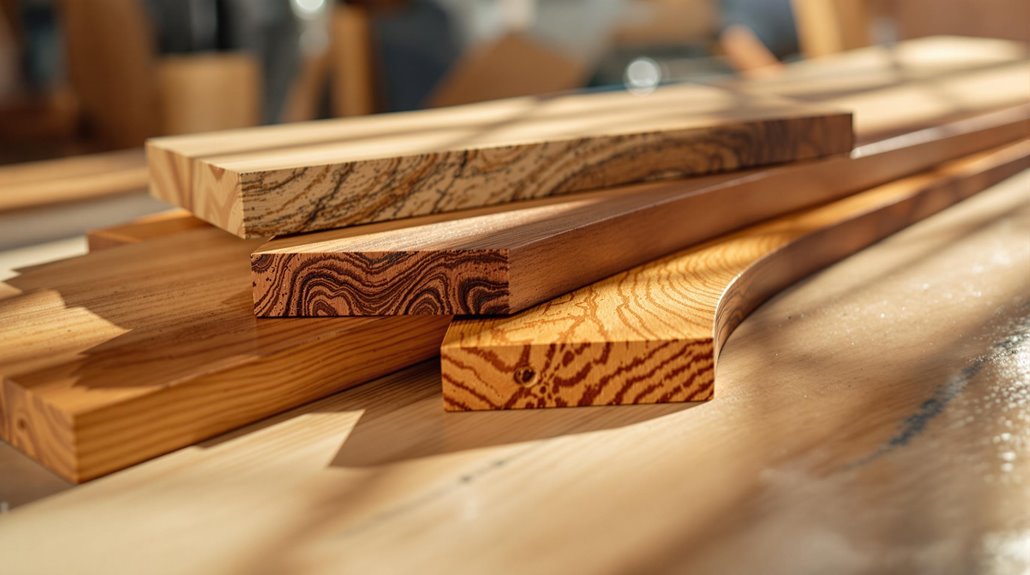The best solid wood depends on several criteria, including durability, aesthetics, workability, and sustainability. Hardwoods like oak and maple are known for their strength and versatility, while exotic species such as Patagonian Rosewood offer superior hardness and impact resistance. Price varies considerably, with domestic types generally more affordable than imported ones. Sustainability is also essential; responsible sourcing and certification guarantee environmental protection. Each wood type has ideal uses, from furniture to outdoor applications, which should inform selection. A thorough exploration of these factors reveals the best choice for your specific project or intention.
Durability of Solid Woods
Although solid wood is renowned for its beauty and structural integrity, its durability is greatly influenced by various environmental factors, natural defects, and biological agents. Humidity and moisture levels play an important role, as wood in damp conditions is more susceptible to warping and cupping. In addition, temperature fluctuations can weaken wood; low temperatures enhance strength, while high temperatures diminish it. Natural defects, such as knots and grain irregularities, notably reduce wood's structural strength. Moreover, biological agents like insects and fungi can deteriorate wood over time, necessitating regular maintenance and inspections. Protective measures, including preservatives and proper installation techniques, are essential for enhancing wood durability and prolonging its service life, ensuring that solid wood maintains its integrity over the years.
Aesthetic Appeal Comparison
The aesthetic appeal of solid wood furniture is greatly influenced by both color variations and the unique grain patterns found in different species. Each type of wood offers distinct hues, from the rich reds of mahogany to the light tones of maple, while the grain patterns can range from straight and uniform to intricate and swirling textures. Understanding these elements not only enhances the visual impact of furniture but also allows for greater customization, ensuring that each piece can reflect individual style and preference.
Color Variations in Woods
Color variations in wood species greatly contribute to their aesthetic appeal, offering a unique visual character that can enhance interior design. For instance, oak displays a warm, golden tone with a spectrum from light to dark brown, while mahogany presents a rich reddish-brown that varies by cut. Walnut exhibits significant color differences, characterized by deep chocolate-brown hues, whereas ash tends to have more uniform light shades. Factors influencing these variations include the inherent color of raw wood, stain absorption characteristics, and exposure to light, which can deepen colors over time. Additionally, regional and seasonal variations add to the uniqueness of each species, creating opportunities for dynamic flooring patterns that engage the eye and elevate overall design aesthetics.
Grain Patterns and Texture
Grain patterns and textures in solid wood play a crucial role in defining the overall aesthetic appeal of various wood species. The straight grain, characterized by its uniform linear appearance, is highly prized for its rarity and modern elegance, often sourced from older trees. In contrast, flat grain showcases curvy growth ring patterns, offering a unique texture that varies in impression and is more widely available. Other grain types, such as spiral, interlocked, and irregular grains, contribute unique visual dynamics to the wood. Additionally, cutting methods like plain, quarter, and rift sawn greatly impact the resulting grain patterns, enhancing the wood's stability and aesthetic appeal. Understanding these factors is essential for selecting the best wood for design applications.
Pricing of Different Woods
The pricing of different woods varies considerably, influenced by factors such as wood type, thickness, and grade. For instance, while domestic woods like White Pine are budget-friendly at approximately $3.75 per board foot, exotic options like Cocobolo can reach $96.00 per board foot, highlighting the range of costs available in the market. Understanding these pricing dynamics is essential for consumers seeking to make informed decisions based on their budget and project requirements.
Cost Comparison Among Woods
When considering the pricing of different woods, it's essential to evaluate the cost range associated with various hardwoods, both common and exotic. Common hardwoods like oak range from $7.50 to $15.25 per board foot, while maple can cost between $6.75 and $25.00. In contrast, cherry and walnut have higher price points, with cherry ranging from $89.00 to $169.00 and walnut between $6.00 and $25.00. Exotic hardwoods command even greater prices; for instance, cocobolo and macassar ebony can cost around $89.00 to $96.00 and $85.00 per board foot, respectively. Additionally, engineered hardwoods can be more affordable, typically ranging from $6 to $18 per square foot, making them a viable option for budget-conscious consumers.
Factors Influencing Wood Pricing
Pricing of different woods is influenced by a variety of factors that extend beyond mere species classification. Market demand and supply dynamics play a significant role; heightened demand from industries such as construction can elevate prices, particularly when supply is limited. Conversely, an oversupply may reduce costs. Environmental regulations also impact pricing; stringent logging laws and certification requirements for sustainable sourcing can increase timber costs. Additionally, technological advancements in processing may raise initial expenditures but can lead to long-term savings. Consumer trends towards eco-friendly materials further influence demand, while quality attributes, including wood density and structural integrity, directly affect pricing. Overall, a complex interplay of economic, environmental, and technological factors shapes the pricing landscape for solid wood.
Budget-Friendly Wood Options
Numerous budget-friendly wood options are available for woodworking enthusiasts and professionals alike, offering quality and affordability. Maple, priced between $2 to $7 per board-foot, is easy to machine and suitable for various projects, though precautions are necessary due to potential toxicity. Poplar, ranging from $2 to $5, is favored for its low cost and fine grain, ideal for painting. Alder, typically $6 to $8, offers a uniform texture and can be stained to mimic more expensive woods. Ash, at $3 to $5, is strong and versatile. For softwoods, Pine is the most economical, while Rustic Oak provides durability at approximately $1.50 per board-foot. Exploring these options can greatly enhance budget-conscious projects without compromising quality.
Sustainability in Wood Choices
As the demand for sustainable resources increases, making informed wood choices has become vital for both consumers and manufacturers. Sourcing wood from responsibly-managed forests guarantees that these ecosystems remain viable, protecting biodiversity and maintaining ecological processes. Sustainable practices, such as continuous replanting and selective logging, help preserve valuable older trees while enhancing carbon sequestration abilities. Certifications like the Forest Stewardship Council (FSC) assure compliance with stringent social, economic, and environmental standards. Additionally, opting for fast-growing species like tulip and black cherry can greatly reduce carbon footprints. The durability of sustainable woods, such as oak and maple, contributes to their longevity, minimizing waste and promoting environmental stewardship in wood consumption. Overall, sustainable wood choices play an essential role in climate change mitigation.
Ideal Uses for Each Type
Selecting the ideal type of wood for specific applications is essential in achieving both aesthetic appeal and functional durability. Bamboo excels in fine furniture, cabinetry, and hardwood flooring due to its strength and water-resistant properties, making it suitable for humid environments. Its lightweight nature allows for ease of handling, while its modern aesthetic enhances interiors. Birch, recognized for its economical value, is ideal for cabinetry, flooring, and toy making, as it takes stains well and offers a smooth surface. Finally, cedar is preferred for outdoor construction, including decks and fences, owing to its weather resistance and insect-repellent qualities. Each wood type presents unique advantages, making them versatile choices across various applications.
Hardness and Workability Ratings
Understanding the hardness and workability ratings of various wood types is essential for both craftsmen and consumers alike. Hardness ratings, measured in lbf (pounds-force), indicate the resistance of wood to indentation. For instance, Patagonian Rosewood ranks highest at 3840 lbf, followed closely by Brazilian Walnut at 3680 lbf. Regarding workability, woods like Hard Maple and White Oak are easy to machine due to their stable grain patterns, while Brazilian Walnut presents challenges due to its density. Additionally, hardwoods with high Janka ratings, such as Brazilian Ebony, exhibit excellent impact resistance, making them suitable for high-traffic areas. Understanding these ratings assists in making informed decisions based on durability, ease of use, and suitability for specific projects.
Final Thoughts on Selection
When choosing solid wood, it is essential to evaluate several key factors that influence both performance and aesthetics. Durability and strength are paramount; denser woods tend to provide greater load-carrying capacity and stability. The grain orientation and the presence of narrow annual rings further enhance these qualities. Fire resistance is also critical; denser woods exhibit a natural ability to resist ignition and can create protective charcoal layers when exposed to flames. Aesthetically, each piece of wood offers unique characteristics, contributing to its authenticity. Environmental considerations, such as sourcing from sustainable forestry, should not be overlooked. Finally, the maintenance and versatility of selected woods, like oak and beech, will determine their suitability for various applications, ensuring long-lasting value.

